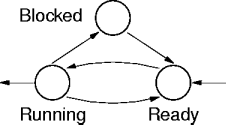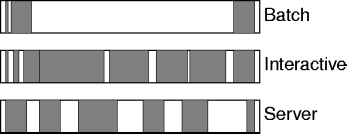Outline
- Scheduling mechanisms.
- Scheduling strategy.
- Eviction and selection strategies.
- Implementation details.
- Examples
The Scheduler
- The scheduler manages the CPUs.
- Shepherds processes to and from the CPU.
- Implements the multi-CPU abstraction.
Process Behavior
- Processes lead a simple life.

- Blocked processes are not runnable and not ready to run for
whatever reason.
- The scheduler is responsible for implementing the arrows.
Process Actions
- From the state diagram, processes spend their lives running and not
running.

- Not running includes blocked and ready.
Process Classes
- You can classify processes based on their running and non-running
behaviors.

- Compute-bound vs. IO-bound computations.
Scheduler Mechanisms
- To do process shepherding, the scheduler must
- Evict the CPU resident process.
- Select the replacement process.
- To do the multi-CPU abstraction, the scheduler must do the between
processes.
- This is also required for process shepherding.
Performance
- Schedulers can be judged by how they effect
- overall system performance and
- individual process performance.
- These two measurements are frequently in conflict.
- The good of the many vs. the good of the few.
System Performance Measures
- Throughput is the number jobs per second.
- Utilization is the system busy percentage.
- High utilization is good.
- An average of any of the individual process measures.
- High average responsiveness or low average turnaround.
Process Performance Measurements
- Service time is the amount of time needed to complete process
execution.
- Wait time is the time between process entry and first process
execution.
- Turnaround time is the time between first execution and last
execution.
- Response time is the time between IO completion and execution in
response.
Scheduler Classification
- Schedulers can be classified along two dimensions:

- When they evict the running process.
- How they select the next running process.
These are the eviction algorithm and selection algorithm
respectively.
Each choice of an eviction and selection algorithm leads to a
scheduler.
First Come First Serve Selection
- Processes gain the CPU in the order they entered the system.
- Treat the ready queue as a queue.
- Assign entry time as the process priority.
- The ready queue is a priority queue.
- These are not the same under pre-emption.
FCFS Analysis
- FCFS selection is easy to implement.
- A strict queue and a simple selection algorithm.
- Entry time is a weak property; other, more important properties are
ignored.
- Except for "queue fairness", FCFS selection is unlikely to provide
useful results.
Shortest Job Next Selection
- Each process declares its expected compute time.
- Order the ready queue by increasing compute time.
- Select the head of the queue.
- This is the process with the shortest estimated execution time.
SJN Analysis
- SJN minimizes average wait time.
- All the processes in front of you have the smallest possible
execution times.
- Large duration jobs may be starved.
- Accurate job-duration estimates are hard to make.
Priority Selection
- Each process Pi has an ordered value pi called its
priority.
- Priority is assigned externally to the OS.
- Pi is selected before Pj if pi < pj.
- Priority assignments may be static or dynamic.
- Dynamic adjustments may be made within the OS or outside it.
Priority Analysis
- Priority selection is the most general policy.
- All other selection schemes can be implemented as some variant of
dynamic priority selection.
- Starvation is possible, particularly with
static priorities.
- Dynamic priorities make it possible for the OS to react to changing
conditions.
Deadline Selection
- A periodic process executes every t ticks.
- And has a deadline of t + d.
- Select the process with the closest deadline.
- This algorithm should be faimilar to all students.
Round Robin Selection
- Strict ready-queue order.
- Evicted processes go to the end of the queue.
- With voluntary eviction, this is equivalent to FCFS scheduling.
Non-Pre-Emptive Eviction
- The process leaves the CPU when it's good and ready.
- It voluntarily suspends execution.
- It terminates.
- The scheduler is powerless to evict the process.
- Except for the OS itself.
Voluntary Eviction
- The executing process determines when it leaves the CPU.
- via a
yield() or sleep() system call, for example.
- Removing pre-emption simplifies the scheduler and decreases scheduling
overhead.
- Non-pre-emption works well for small, compute-bound sets of processes.
Involuntary Eviction
- The scheduler can evict the executing process arbitrarily.
- The process can still voluntarily leave the CPU.
-
Selection-Based Eviction
- Process Pi is executing under SJN selection with expected time
ti.
- Process Pj joins the ready queue with expected time tj <
ti.
- To maintain the SJN policy, the scheduler should replace Pi with
Pj.
- This is known as selection-based eviction.
- Similarly for pure priority selection.
Quantum-Based Eviction
- Each process is allowed to occupy the CPU for a specific time known as
the quantum (also known as the time slice).
- When the quantum expires, the process is evicted.
- Quantum-based eviction and round-robin selection leads to time-sharing
OSs.
Single Scheduler Problems
- What happens when selection produces several candidate processes?
- Several processes with the same priority, or job time, or deadline.
- One scheduler can't meet all process expectations.
- And those that try get complicated quickly.
- An OS may support multiple process classes.
- Foreground and background processes, for example.
Multi-Scheduler Systems
- Using two or more schedulers can solve these problems.
- At an increase in complexity and scheduling overhead.
- Multiple schedulers often uses multiple ready queues.
- On scheduler can move processes between queues.
Implementation Details
- Scheduler implementations have to be efficient.
Context Switching
Examples
Linux Scheduling
BSD Unix Scheduling
Windows Scheduling
This page last modified on 14 November 2004.




